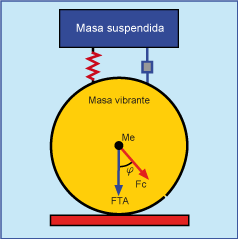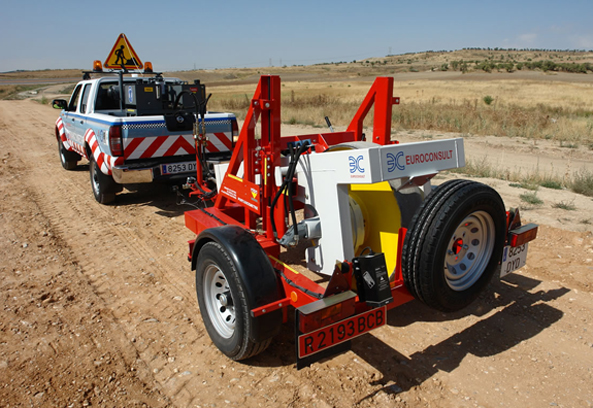Continuous measurement of the bearing capacity of embankments, platforms, track beds and sub-ballast

The Bearing capacity meter is a high-performance unit for measuring the bearing capacity of embankments, platforms, track beds and sub-ballast.
It comprises a wheel with a total weight of 400 kg. containing a 0.3 kg eccentric wheel that moves in a circle perpendicular to the surface to be analysed and rotates in the opposite direction to the movement of the vehicle, at 35 cycles per second (± 3Hz) and 3.6 km per hour. This system enables a test to be run every 0.8 m (1250 readings per kilometre), so that around 20 km of road platform can be analysed per working day.
The unit’s data processing software means that results are available as soon as the test is completed, enabling conclusions to be drawn on the spot and decisions regarding work to be made more quickly.
Operation
The Bearing capacity meter has a suspended mass weighing 600 kg. which acts as a reaction unit for applying the load to the layer to be analysed. Force is applied via the rotation of the eccentric wheel, resulting in a wheel displacement of 0.5 mm. The wheel lifts off the ground and impacts on the test surface 35 times per second.
The strain modulus is calculated by recording the force applied to the material and the strain that it undergoes according to the following expressions:
1.- Measuring the total force applied (FTA) to the surface:

2.- Measuring settlement
The amount by which the ground settles when the force is applied is measured indirectly via the acceleration measured by the acceleration meter on the axle of the eccentric wheel. A double integration (acceleration → velocity → displacement) gives the amount of settling over one complete cycle.
3.- Readouts of bearing capacity data
On the basis of the steps described above, the system obtains readings for FTA and settling over the duration of a single cycle of the eccentric wheel. Data for the same time are cross referenced to give pairs of force/settling readouts that can be shown on a graph. Bearing capacity is then calculated using the regression line delimited by the points between 90% and 30% of FTA.
Equipment
- Truck: used to transport the equipment, house the IT systems and provide an electrical generator and hydraulic power unit.
- Wide-screen front camera with x, y & z co-ordinates for inventorying.
- Trailer: this contains the actual bearing capacity meter. To locate and delimit the areas to be measured, the unit has a GPS system and two distance measuring systems:
- An Encoder on the truck transmission.
- A Radar unit for non-contact measuring.
- Non-destructive testing
- An extremely broad measuring range from 30 MPa to 350 MPa.
- The ability to obtain large amounts of data (up to 20 km can be measured in a single day).
Advantages
- Non-destructive testing
- An extremely broad measuring range from 30 MPa to 350 MPa.
- The ability to obtain large amounts of data (up to 20 km can be measured in a single day).
- Presentation of results on the spot.

